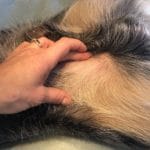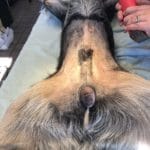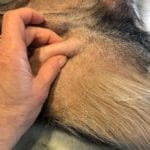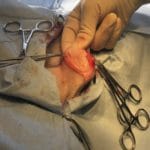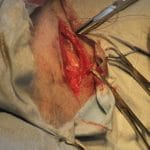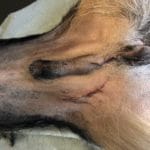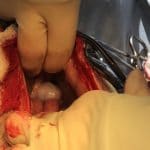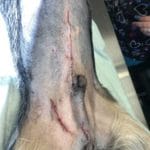Cochise has been coming to our veterinary clinic since he was four months old. He, from that very fist puppy exam with us was determined to have only one palpable testicle in the scrotum. He also had a very small umbilical hernia.
One of the most important parts of having a puppy is routine examinations with a veterinarian who can help you manage and monitor their growing up and care. There’s a lot that goes into raising a happy, healthy, fit for life puppy.
As soon as I see a failure to develop properly (this is both anatomically AND emotionally) I start providing guidance, benchmarks, and a very well documented laid out plan. In puppy appointments I talk A LOT! I want everyone to understand the concerns we find, and know that they have help in the steps and path ahead.
Cochise (unlike many other crytporchids) had only one palpable testicle. The right testicle was in the right scrotal sac and it was the appropriate size for his age. We also knew how old he was. In almost all cases with cryptorchid puppies I give them until 8-12 months to see if that wandering lost teste can find its way.
To be honest, if it hasnt made it at least to the inguinal area (outside of the body wall and in the area of the crease between the leg and the scrotum) it is probably never going to make it there.
If there is no palpable teste by 12 months I recommend neutering and an exploratory surgery.
As with all cryptorchids make sure you look for any other congenital issues (like hernias, abnormal mouths or bite, and any kind of internal organ issues. All cryptorchids should be neutered and not permitted to be used as a breeding pet.
If your veterinarian is not prepared and comfortable with an abdominal exploratory surgery when the missing testicle is not found in the scrotum or inguinal area please do not have him neutered there. I have seen too many dogs (and cats) not have the surgery they needed because the veterinarian doing the neuter would nnot, or, did not go into the abdomen to find the missing testicle.
Testicles that do not descend can cause a Sertoli Cell tumor (more on that here; https://www.petmd.com/dog/conditions/cancer/c_dg_sertoli_cell_tumor)
These in my experience are one of the worst ways for a dog to die. Totally preventable and always too late when discovered to save the pets life.
All dogs with undescneded testicles should have exploratory surgery done, and hormone testing post op if the testicle is not found (some dogs may only have one testicle).
For Cochises surgery I did the following;
1. spoke to his family about the procedure. Cost and possible difficulty in looking for the missing testicle. Possibility of having to look in the abdomen. Surgical time, and therefore cost of procedure too.
2. Prepared Cochise for a longer than usual surgery.
3. I did a routine castration on the normal testicle.
4. I looked in the inguinal area of the side missing the testicle.. There is usually fat pads here and the missing testicle is always smaller than the regular one (well smaller until it turns into cancer. Then it can grow to the size of a cantaloupe!)
5. If it cannot be found in the inguinal area we look in the abdomen for it.
For Cochise this meant three incisions. I spent time looking everywhere before I opened up his abdomen. An abdominal exploratory surgery takes time. Patients need to be kept warm. You have to be prepared to look for a needle in a haystack. Once I thought I found the missing testicle but it was about the size of a pencil eraser. I had to submit it for microscopic evaluation to convince myself it was what I thought it was! (thankfully I was correct).
Cost of Cochises surgery is as follows;
anesthesia $125
iv fluids and catheter $90
exploratory surgery and castration $250
antibiotics and post op pain medications $30
post op pet shirt and ecollar $45
suture and surgical pack $150
Cochises story is published by myself, the providing surgeon and with permission from his family (thank you!)


